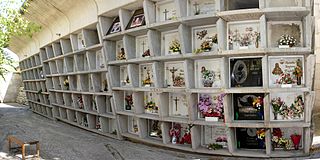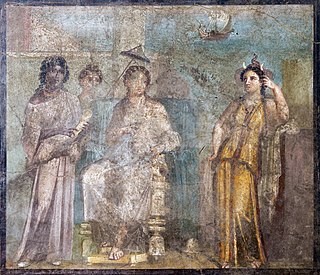Related Research Articles

The Alexander Mosaic is a Roman floor mosaic originally from the House of the Faun in Pompeii that dates from c. 100 BC. It is typically dated in the second half of the century between 120 and 100 B.C. It depicts a battle between the armies of Alexander the Great and Darius III of Persia and measures 2.72 by 5.13 metres. This work of art is a combination of different artistic traditions such as Italic, Hellenistic, and Roman. The mosaic is considered "Roman" based on the broader context of its time and location in relation to the later Roman Republic. The original is preserved in the Naples National Archaeological Museum. The mosaic is believed to be a copy of an early 3rd-century BC Hellenistic painting.

Antiochia ad Cragum also known as Antiochetta or Latin: Antiochia Parva is an ancient Hellenistic city on Mount Cragus overlooking the Mediterranean coast, in the region of Cilicia, in Anatolia. In modern-day Turkey the site is encompassed in the village of Güneyköy, District of Gazipaşa, Antalya Province.

Hellenistic art is the art of the Hellenistic period generally taken to begin with the death of Alexander the Great in 323 BC and end with the conquest of the Greek world by the Romans, a process well underway by 146 BCE, when the Greek mainland was taken, and essentially ending in 30 BCE with the conquest of Ptolemaic Egypt following the Battle of Actium. A number of the best-known works of Greek sculpture belong to this period, including Laocoön and His Sons, Venus de Milo, and the Winged Victory of Samothrace. It follows the period of Classical Greek art, while the succeeding Greco-Roman art was very largely a continuation of Hellenistic trends.

Loculus, plural loculi, is an architectural compartment or niche that houses a body, as in a catacomb, hypogeum, mausoleum or other place of entombment. In classical antiquity, the mouth of the loculus might be closed with a slab, plain, as in the Catacombs of Rome, or sculptural, as in the family tombs of ancient Palmyra.

In late Classical Greek art, ichthyocentaurs were centaurine sea beings with the upper body of a human, the lower anterior half and fore-legs of a horse, and the tailed half of a fish. The earliest example dates to the 2nd century B. C., among the friezes in the Pergamon Altar. There are further examples of Aphros and/or Bythos, the personifications of foam and abyss, respectively, depicted as ichthyocentaurs in mosaics and sculptures.

A Roman mosaic is a mosaic made during the Roman period, throughout the Roman Republic and later Empire. Mosaics were used in a variety of private and public buildings, on both floors and walls, though they competed with cheaper frescos for the latter. They were highly influenced by earlier and contemporary Hellenistic Greek mosaics, and often included famous figures from history and mythology, such as Alexander the Great in the Alexander Mosaic.

The biga is the two-horse chariot as used in ancient Rome for sport, transportation, and ceremonies. Other animals may replace horses in art and occasionally for actual ceremonies. The term biga is also used by modern scholars for the similar chariots of other Indo-European cultures, particularly the two-horse chariot of the ancient Greeks and Celts. The driver of a biga is a bigarius.

Goddess Africa, also known as Dea Africa, was the personification of Africa by the Romans in the early centuries of the common era. She was one of the fertility and abundance deities to some. Her iconography typically included an elephant-mask head dress, a cornucopia, a military standard, and a lion.
Ada Cohen is an American art historian. She serves as Professor of Art History and Israel Evans Professor in Oratory and Belles Lettres at Dartmouth College. Her work focuses on ancient Greek art, particularly imagery of Alexander the Great. From 1990-1991, she was a member of the Columbia University Society of Fellows in the Humanities.

The mosaics of Delos are a significant body of ancient Greek mosaic art. Most of the surviving mosaics from Delos, Greece, an island in the Cyclades, date to the last half of the 2nd century BC and early 1st century BC, during the Hellenistic period and beginning of the Roman period of Greece. Hellenistic mosaics were no longer produced after roughly 69 BC, due to warfare with the Kingdom of Pontus and subsequently abrupt decline of the island's population and position as a major trading center. Among Hellenistic Greek archaeological sites, Delos contains one of the highest concentrations of surviving mosaic artworks. Approximately half of all surviving tessellated Greek mosaics from the Hellenistic period come from Delos.

Boxford Roman mosaic is a mosaic at Boxford, West Berkshire, England, rediscovered during an archaeological dig in August 2017. It dates from the Roman period. The 4th century (AD) mosaic is over 6 metres (20 ft) long. Its central panel is thought to show Bellerophon, at the court of either Iobates or Proteus, battling Chimera.

Mireille Corbier is a French historian of Classical history. Currently Research Director emerita at Centre national de la recherche scientifique (CNRS), she has published a number of books and articles, and since 1992 has been editor-in-chief of L'Année épigraphique.
Rebecca Jane Sweetman is Professor of Ancient History and Archaeology and Head of the School of Classics at the University of St Andrews. Sweetman is known in particular for her work on the archaeology of Roman and Late Antique Greece. From September 2022, she will take up an appointment as Director of the British School at Athens.
Véronique Dasen is a Swiss archaeologist and Professor in Classical Archaeology and Art History at the University of Fribourg. Her research is led in a multidisciplinary and anthropological perspective. Her research interests range from ancient iconography and material culture, the history of the body, of medicine and magical practices to gender studies, history of childhood, and ludic culture.
Louise Revell is a Roman archaeologist, currently Associate Professor in Roman Studies at the University of Southampton. Revell's research focuses on provincial archaeology of the western Roman empire.
Rebecca Jones is Head of Archaeology and World Heritage at Historic Environment Scotland.

The Temple of Juno Caelestis is a archaeological site in Dougga, Tunisia. The ruined temple was dedicated to the Roman goddess Juno, herself an evolution of the Punic goddess Tanit. The temple was built between 222 and 235 AD, and is one of the best preserved temples dedicated to Juno in Africa.
Astrid van Oyen is currently an Assistant Professor in Classics at Cornell University. She is a leading archaeologist studying the social, economic and cultural aspects of empire, rural economies, craft production, and storage in Italy and the western provinces.
Katherine Demuth is an American professor of linguistics and the director of the Child Language Centre at Macquarie University. She was elected a Fellow of the Royal Society of New South Wales in February 2018, and is a Fellow of the Academy of Social Sciences in Australia (FSSA).
Kristina Milnor is Professor of Classics in the Department of Classics and Ancient Studies at Barnard College, Columbia University. She specialises in Latin literature, Roman history, feminist theory and gender studies.
References
- ↑ Dunbabin, Katherine M. D. (30 August 2016). Theater and Spectacle in the Art of the Roman Empire. Cornell Studies in Classical Philology. Ithaca, NY: Cornell University Press. ISBN 9780801456886.
- ↑ Jacobs, P. M., ed. (1976), "History Theses 1901-1970: Historical research for higher degrees in the universities of the United Kingdom", British History Online, Institute of Historical Research, pp. 5–15, retrieved 22 January 2019
- ↑ Dunbabin, Katherine M. D. (1999), Mosaics of the Greek and Roman World, Cambridge University Press, p. xxi, ISBN 9780521002301
- ↑ Cunliffe, Barry (November 1980), "Katherine M. D. Dunbabin: The mosaics of Roman North Africa: studies in iconography and patronage. Oxford Monographs on Classical Archaeology. Oxford: Clarendon Press, 1978. 303 pp., 88 pls. (8 in colour). £27.50.", Antiquity, 54: 239–241, doi:10.1017/S0003598X00043416
- ↑ "Some answers from the floor: Mosaics tell us more than we realise about life in classical times", The Telegraph, 4 January 2000, archived from the original on 27 February 2016, retrieved 21 February 2019
- ↑ Dunbabin, Katherine M. D. (2003), The Roman Banquet: Images of Conviviality, Cambridge University Press, pp. xv–xvi, ISBN 0-521-82252-1
- ↑ Dunbabin, Katherine M. D. (2003), The Roman Banquet: Images of Conviviality, Cambridge University Press, p. xvi, ISBN 0-521-82252-1
- ↑ "Two McMaster researchers awarded prestigious Killam Fellowships". dailynews.mcmaster.ca. 25 February 2004. Retrieved 23 November 2018.
- ↑ Classics Departments / Programmes in Canada. New Hirings, Retirrements and Departures (tenure-stream positions) 2005-2008 (PDF), Classical Association of Canada, retrieved 22 January 2019
- ↑ "Editorial board". Cambridge Core. Retrieved 23 November 2018.
- ↑ "Prelims and table of contents". Journal of Roman Archaeology. 22: 1–5. 2009. doi:10.1017/S1047759400021747.